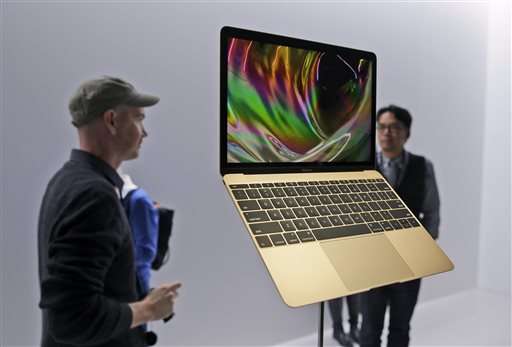Review: New MacBook brings iPad's minimalism to laptop

From the moment I took it out of the box, Apple's new MacBook looked and felt like an iPad.
The laptop is Apple's lightest and thinnest yet and borrows many of the iPad's designs, including the lack of a fan. The result is a 2-pound (0.92 kilogram) laptop that feels almost non-existent on my lap. Yet it packs in a lot of power, including a high-resolution display and a sturdier keyboard.
The new MacBook goes on sale Friday starting at $1,299 in silver, gold or gray (the same choices as the iPad). Its box even resembles the iPad's.
___
NEW KEYBOARD
To make the MacBook as thin as it is—a half-inch (13.1 millimeters) at the thickest point—Apple had to redesign the keyboard. Traditional keys need to be tall to properly strike the mechanism that records the keystroke. Otherwise, you'd need to strike at the center, which many people don't do. With the redesign, you can strike shorter keys from the edge. Those shorter keys help keep the laptop thin.
The new keyboard takes getting used to, even after a week of testing. I feel as though I need to press more firmly. But taller, old-style keys on some keyboards have started to feel flimsy by comparison, as though about to come off their springs. The new keyboard does get more comfortable over time— just don't expect to write a novel on Day One.
Although it's small, the new MacBook retains a full-size keyboard. In fact, that's why the screen is 12 inches—it matches how much space the keyboard needs. (The screen, incidentally, is stunning—compared with MacBook Air's lower-resolution screen. The fish in "Finding Nemo" look colorful and sharp.)
___
NEW TOUCHPAD
Also contributing to thinness is a new touchpad that Apple calls Force Touch. On earlier MacBooks, the touchpad acts like a springboard. When you press it, you're physically moving it to activate the sensor. You also have to press harder toward the back, near the springboard's hinge, than you do in front. In the new MacBook, sensors are embedded, so you can get the same response anywhere.
There's also a second sensor now to record the amount of pressure you're applying. A click followed by a firm press activates a number of features. Press on a document icon, and a preview pops out. Press on an address in an email, and a map opens up. On some video apps, the pressure determines how quickly you forward or rewind. These gestures primarily work with Apple apps for now, but other app developers can incorporate the functionality.
The MacBook does all this magically without the touchpad actually moving. Apple added a haptic engine to replicate the feeling of clicking and pressing. It isn't needed technologically, but will help keep things familiar for users.
Apple also updated its high-resolution, 13-inch version of the MacBook Pro with this new touchpad. I imagine future models getting it, too.
___
MINIMALISM
Most of the expansion ports have disappeared. In its place is a single charging port that's also used for accessories and video output. It uses a new standard called USB-C.
The problem is most gadgets still use older USB ports, so you'll need a $19 adapter for a single device. It's likely outside parties will soon make adapters to connect multiple USB devices simultaneously, but if you use USB regularly, you might consider getting an Air or Pro model instead.
A $79 adapter gives you video output, with a USB port thrown in. You also might need a $19 extender for the power cord, as the box no longer comes with it. I find the included cord too short. Cord extenders from older MacBooks will work, too.
Speaking of power, I got eight to 11 hours of battery life on a single charge, which is impressive given that the high-resolution screen requires more power than regular screens. Apple saved energy by having individual pixels on the screen let through more light. It also squeezed in more battery by shrinking the circuit board and using odd shapes to fit into all remaining space. The battery life isn't as good as what you get on a 13-inch Air, but it should be adequate for most days.
© 2015 The Associated Press. All rights reserved.



















